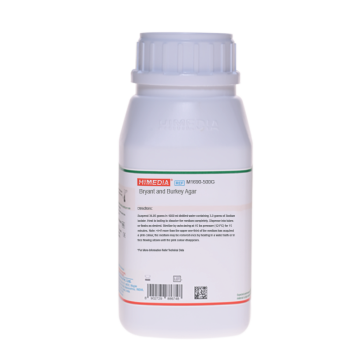 Your enquiry has been submitted
Your enquiry has been submitted
Bryant and Burkey Medium
Intended Use
Recommended for detecting and enumerating spores of lactate fermenting Clostridium in milk and dairy products.
Composition**
| Ingredients | Gms/Litre |
|---|---|
| Tryptone | 15.000 |
| Yeast extract | 5.000 |
| HM peptone B # | 7.500 |
| Sodium acetate | 5.000 |
| L-Cystine dihydrochloride | 0.500 |
| Resazurin | 0.0025 |
Final pH (at 25°C) 5.9±0.2
**Formula adjusted, standardized to suit performance parameters
* Equivalent to Beef extract
Directions
Suspend 33.0 grams in 1000 ml purified/distilled water containing 5 grams of Sodium lactate. Heat if necessary to dissolve the medium completely. Mix well and dispense into tubes or flasks as desired. Sterilize by autoclaving at 15 lbs pressure (121°C) for 15 minutes.
Principle And Interpretation
Bryant and Burkey Medium is used to enumerate the spores of gasogenic clostridia that are responsible for swelling of cheese in dairy industry (1, 2). In normal conditions of use, the medium allows the growth of other microorganisms also which are not directly related to cheese alteration, e.g. Clostridium sporogenes or Clostridium butyricum. Germination and growth of butyric acid bacteria (BAB) causes severe defects in cheese with silage being the main source of BAB spores in cheese milk (6). Clostridia spores are heat resistant and therefore can contaminate cheese brines. The gas produced by the growth of clostridia swells the cheese and is responsible for defect known as butyric swelling, resulting in bad taste. The main species causing this butyric swelling defect is Clostridium tyrobutyrium.
Recommended technique for estimation of Clostridium is to enumerate the spores by the MPN method. Resazurin is a redox indicator and monitors the oxygen level turning from pink under aerobic conditions to colourless under anaerobic conditions. The nutrient composition of the basal medium, particularly of tryptone, yeast extract, HM peptone B and L-cysteine HCl help in rapid growth of Clostridium species. Sodium acetate promotes spore germination (5) and improves the selectivity of the medium. Sodium lactate is fermented under anaerobic conditions by Clostridium tyrobutyricum. A pink colour indicates the presence of oxygen in the media which turns colourless on boiling.
Type of specimen
Dairy samples
Specimen Collection and Handling
Test sample must be previously decontaminated by heating up for 10 minutes at 75°C in order to destroy all the vegetative forms while only leaving the spores alive. The tubes of the medium are then boiled to regenerate anaerobiosis and cooled down to 25-30°C. These tubes are inoculated with the sample and overlaid with 2 cm of sterile paraffin and incubated for upto 7 days at 37°C. Examine the tubes after every 48 hours. A raised paraffin plug indicates gas formation. Tubes will be declared positive if they show clear gas production and MPN index is used to calculate the number of Clostridia. After use, contaminated materials must be sterilized by autoclaving before discarding.
Warning and Precautions :
Read the label before opening the container. Wear protective gloves/protective clothing/eye protection/ face protection. Follow good microbiological lab practices while handling specimens and culture. Standard precautions as per established guidelines should be followed while handling specimens. Safety guidelines may be referred in individual safety data sheets.
Limitations :
- Proper anaerobic conditions to be provided for the growth of Clostridia.
- Some strains may show poor growth due to nutritional variations.
Performance and Evaluation
Performance of the medium is expected when used as per the direction on the label within the expiry period when stored at recommended temperature.
Quality Control
Appearance Cream to yellow homogeneous free flowing powder
Colour and Clarity of prepared medium Light amber coloured, clear solution when hot, becomes pink-red upon cooling
Reaction Reaction of 3.3% w/v aqueous solution at 25°C. pH : 5.9±0.2
pH 5.70-6.10
Cultural Response
Cultural characteristics observed under anaerobic conditions after an incubation at 35-37°C for 6 days.
| Organism | Growth | Gas production |
|---|---|---|
| Clostridium tyrobutyricum ATCC 25755 | good | positive |
Storage and Shelf Life
Store between 10-30°C in a tightly closed container and the prepared medium at 15-25°C. Use before expiry date on the label. On opening, product should be properly stored dry, after tightly capping the bottle in order to prevent lump formation due to the hygroscopic nature of the product. Improper storage of the product may lead to lump formation. Store in dry ventilated area protected from extremes of temperature and sources of ignition. Seal the container tightly after use. Product performance is best if used within stated expiry period.
Disposal
User must ensure safe disposal by autoclaving and/or incineration of used or unusable preparations of this product. Follow established laboratory procedures in disposing of infectious materials and material that comes into contact with sample must be decontaminated and disposed of in accordance with current laboratory techniques (3,4).
Reference
- Bergeres J. L. and Sivela S., 1989, Detection and enumeration of Clostridial spores related to cheese quality-Classical and new methods, FIL-IDF Bull. 51:18-23.
- Bryant M. P. and Burkey L. A., 1956, J. Bacetriol., 71: 43-46.
- Isenberg, H.D. Clinical Microbiology Procedures Handbook 2nd Edition.
- Jorgensen, J.H., Pfaller, M.A., Carroll, K.C., Funke, G., Landry, M.L., Richter, S.S and Warnock., D.W. (2015) Manual of Clinical Microbiology, 11th Edition. Vol. 1.
- Touraille C. and Bergere J. L., 1974, Biochimie, 56: 404-422.
- Vissers M. M. M., Drichuis F., Giffel T., John P. D., Lankveld J. M. G., 2007, J. Dairy Sci., 90:928
| Product Name | Bryant and Burkey Medium |
|---|---|
| SKU | M1385 |
| Product Type | Regular |
| Physical Form | Powder |
| Origin | Animal |
| Packaging type | HDPE |
| References | 1. Bryant M. P. and Burkey L. A., 1956, J. Bacetriol., 71: 43-46. |
| Customized Product Available | No |






